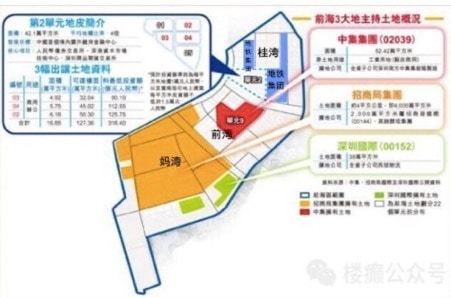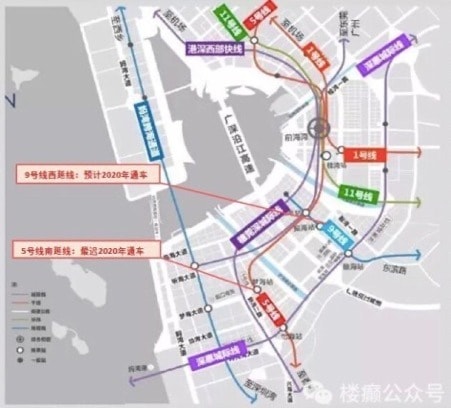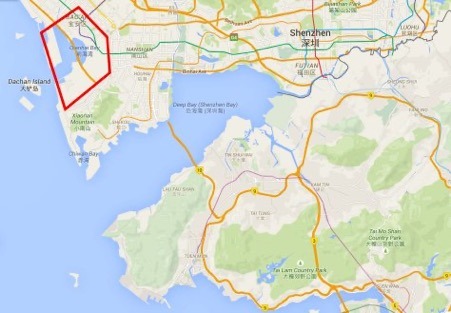Qianhai in Shenzhen is one of three areas designated by Beijing for the next stage of China’s Reform and Opening. It has been slow getting going, but changes are being accelerated, writes Anthony Lawrance
Facing the South China Sea, Qianhai doesn’t have much room for future expansion – unless further reclamation work is done. However for now, that suits local and national officials just fine: What Qianhai is set to accomplish in the coming years under the Greater Bay Area masterplan, is all about quality rather than quantity.
The area’s official name is the Qianhai-Shenzhen-Hong Kong Modern Service Industry Cooperation Zone. The name gives a hint of what it is all about: bringing Hong Kong and Shenzhen together, step by step. This gradual process foresees what will happen in 2047, when Hong Kong will officially join the People’s Republic of China.
Qianhai’s location is symbolic, too. It sits close to the Shenzhen Bay Bridge, which connects Hong Kong to the Shekou port, the area of Shenzhen where Reform and Opening began.
Today, the area is probably the most internationalised of any in China outside of Shanghai. For starters, its entertainment district looks much like Hong Kong’s clubbing district Lan Kwai Fong.
Situated ten minutes north of Shekou, around the artificially-constructed Qianhai Bay, the special zone has no barriers or fences. On this section of reclaimed land, construction crews and office workers alike work around the clock. Thanks to them, Shenzhen has come to define China’s frenetic pace of economic development like no other.
Master planners in Beijing founded Qianhai in 2009, under the framework of the province’s Pilot Free Trade Zone initiative, which includes Nansha in Guangzhou, and Hengqin in Zhuhai.
Qianhai is geographically strategic: it acts as a bridge to Hong Kong, and as a gateway for the Belt and Road Initiative. Other than its tactical position, it is a place for further economic and legal experimentation.
Authorities have devised four main goals for the area, which will serve as:
- An innovation area for modern service industry sectors
- A cluster area for the development of modern services
- A pilot area for close cooperation between the mainland and Hong Kong
- A leading area for industry upgrades in the Pearl River Delta (Greater Bay Area)
As a pilot area, it will serve as the centre for bold, innovative change. In Qianhai, new types of courts can be set up, for instance; it is a place where special incentives can be offered to investors, both corporates and individuals; a place where the challenging influences of Hong Kong can be welcomed in, contained if necessary, and adapted to China’s needs.
Although it is still largely a construction zone, Qianhai is already getting Hong Kongers through the door. Latest available data shows that a total of 8,031 Hong Kong companies have settled in the zone, which amounts to a registered capital of RMB893.726 billion. They include financial heavyweights HSBC, Bank of East Asia, and Credit Suisse.
Latest available data shows that a total of 8,031 Hong Kong companies have settled in the zone
Most of the early movers are in financial services and logistics. Altogether they contribute around 20 percent of the GDP generated in Qianhai, and pay around 23 percent of its tax revenues. However this is nothing compared to what’s in the pipeline. By the end of 2021, Qianhai aims to have a total population of 100,000 people, including 70,000 workers, plus 30,000 inhabitants.
What took so long?
By Shenzhen’s standards, Qianhai has been a slow starter. Between 2010, when reclamation work began, and the end of last year, only 182 buildings in the area had been topped-out, half of which were ready to be fitted out. With just 1.95 million square metres of usage space, it was a far cry from the 23.8 million square metres envisaged in the masterplan. Today, Qianhai is a long way from a “new Manhattan”.
Why has it taken so long to get going? Two reasons, it seems – one governed by market forces, the other by administrative forces.
The market forces at work in Qianhai provide a fascinating glimpse of the area’s potential. Unlike many other parts of Guangdong, most of Qianhai’s land was reclaimed by companies that have a longer track record of “just getting on” with development. In Guangzhou, on the contrary, the land is mainly state-owned.
Qianhai belongs to three of the most successful commercial groups in China: China International Marine Containers Group, China Merchants Group and Shenzhen International Holdings. These groups were born in the furnace of the country’s early days of Reform and Opening. It has taken the city government longer to negotiate development plans with these three than might have been expected elsewhere.
Until 2016, the government only had around a quarter of the land in Qianhai ready for development. The Guiwan and Qianwan districts went first, with 3 million square metres of the 14 million square metres total. By the end of 2017, the city government had signed off joint ventures with the big three companies, which allowed the rest of the district to get going. Now, a drive past the area reveals a hive of activity.

The land in Qianhai held by the three largest landlords
The second factor holding back Qianhai until recently was just an administrative snafu that needed time to fix. Due to restrictions on the height of buildings, companies could not get the developable floor space they needed to make a decent return on investment.
Once the 153-metre cap was raised to 280-350 metres in 2016, however, it was all systems go. Qianhai now has a total buildable area of 23.8 million square metres. With around one-third of this under construction, it will take another 13 to 15 years to complete the district’s development – which happens to be in line with the government’s target date for the Greater Bay Area, in 2035.
What comes next?
Qianhai isn’t currently the easiest place to get to from Hong Kong. To get there, you must either drive across the Shenzhen Bay Bridge with a Cross-Boundary license, or (if you can afford it), take a seven-seater limousine. But if you are living in Shenzhen, three subways connect to the area. The ferry service running into Shekou is convenient, but not as timely as busy Hong Kong investors and executives would like. That will also change fairly soon.

The planned road network for Qianhai
Currently, the high-speed railway only passes through Futian, which is a 40-minute taxi ride away from Qianhai. But in a few years, Qianhai will have no fewer than 15 railway lines running through it. In addition to Shenzhen metro lines, these will include intercity railway lines going up the coast to Dongguan and eastwards to Huizhou. In addition, the city will be equipped with high-speed railway lines direct from Kowloon West in Hong Kong.
The Qianhai transportation hub is located in Guiwan, in the middle section of Qianhai’s crescent bay. It will soon offer airport check-in services and have an immigration control station. It plans to complete the underground section by next year. Upon full completion, the hub is expected to have a daily passenger flow of 750,000. This number doubles the current number of crossings between Macau and Zhuhai at peak periods.
Where are the opportunities?
The early construction of Qianhai has been concentrated in Quiwan, Mawan and Qianwan. Among the 40 development projects, Quiwan has 24, Mawan 8 and Qianwan 9.
The projects in Quiwan started the earliest. About two-thirds of the land in Quiwan already has projects currently under construction. The 1.1 square kilometre Quiwan financial district has been made the priority.
Quiwan has a total of 8.84 million square meter building area – about half of that will be completed and be in operation within the next three years.
The innovation hub
Another incubator in the city drawing media attention is the Qianhai Shenzhen-Hong Kong Youth Entrepreneur and Innovation Hub. What makes it different is the focus on cooperation with Hong Kong entrepreneurs.
Located in the pilot district for cooperation between mainland China and Hong Kong, the incubator was established in 2014 by the Qianhai Authority. The largest youth associations in Shenzhen and Hong Kong – the Hong Kong Federation of Youth Groups and Shenzhen Youth Federation – are jointly responsible for its operation.
“By providing discounted office space, financial support and startup training, it is designed to attract entrepreneurs aged 18 to 45, with a large proportion from Hong Kong. Up to the middle of last year, it had served 388 startups, of which 190 are from Hong Kong and Macau,” says Wang Yanxia, deputy director of Qianhai Authority. The project is now expanding to a second phase, with 19,000 sqm of floor area added to the original hub, which is expected to open by the end of this year, Wenweipo reported.




